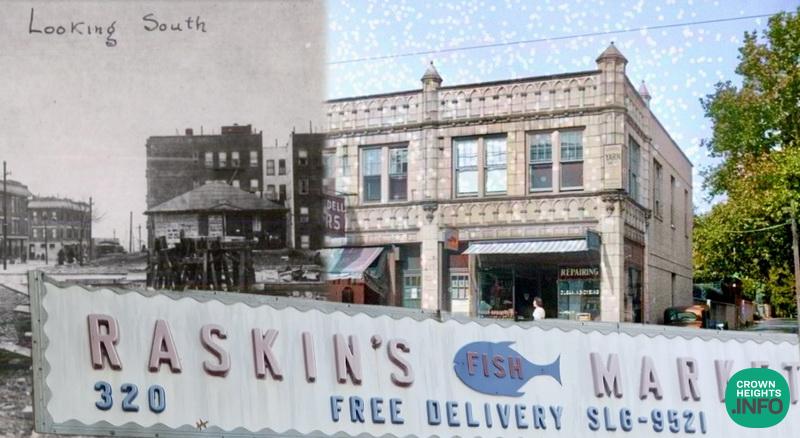
Crown Heights History: Raskin’s Fish Market 320 Kingston Ave
by Crown Heights Historian Shmully Blesofsky, Instagram account History of Crown Heights.
At the intersection of President and Kingston Avenues stands one of the most recognized storefronts in Crown Heights—the legendary Raskin’s Fish Market. This iconic shop, one of the oldest in the neighborhood, has been a cornerstone of the community for decades.
By 1922, Crown Heights had blossomed into a thriving neighborhood, with Kingston Avenue developing into a bustling retail hub. However, the northwest corner of President and Kingston, where Raskin’s and Gombos now stand, remained vacant. This plot was owned by early real estate investor Jane E. Hadden, who, in collaboration with the Eastern Parkway Company, acquired land throughout Crown Heights. She held the property until 1920, when it was purchased by Bertha Lurie. Lurie, also a philanthropist, played a significant role in founding the Hebrew Home of the Aged, which provided a safe haven for elderly Jews.
Bertha Lurie lived at 1451 Union Street in what used to be the Kollel building. That family probably deserves an article of its own. She was married to Leib Lurie, one of the founders of the Brooklyn Jewish Center. Leib Lurie was a builder who also operated a successful mortgage company. Their son, Irving H. Lurie, followed in his parents’ footsteps, becoming a prominent developer and designing over 500 synagogues across America.
In the early 1920s, Bertha Lurie filed plans to build a commercial property on the corner lot, but she faced opposition from local Jewish businessmen living on President Street, such as Max Welinsky, who had recently built an upscale mansion next door (Dr. Feldmans house). Welinsky and others, including Rose Bloom, William Goodman, and Louis Halperin, argued in their lawsuit that the property fronted President Street, and the block’s original deeds, drawn by the Eastern Parkway Company, allowed only for single-family homes valued at a minimum of $10,000. Additionally, the Board of Estimate adopted a resolution changing President Street from a business to a residential zone. The group hoped that the corner would feature a mansion similar to what is now the Tzach building.
Ultimately, Justice Callaghan ruled that Building Superintendent Kleinert could issue a permit to the Justin Building Corporation, allowing the construction of a building with stores and apartments at the corner of Kingston Avenue and President Street. Despite opposition, Bertha Lurie’s plans for four storefronts with apartments above were approved, with construction completed in 1926 at a cost of $60,000.
Possibly because of its proximity to President Street’s exclusivity, J. Sarsfield Kennedy, an architect renowned for designing some of the city’s most creative residential and civic buildings, was chosen. He crafted the building with a limestone façade, using elements of Gothic revival and Roman revival architecture. The decorative limestone façade features intricate details, including geometric patterns and arched shapes.
Over the years, the stores housed upscale women’s clothing retailers. The first occupant of 320 Kingston Avenue was Evelyn Millinery, owned by Evelyn Rubin and Irene Perlman, followed by Myers Dress Shop. In the 1930s, it became a shoe repair shop.
In 1954, the Raskin family arrived in America, initially settling in Brownsville before moving to Crown Heights. Orphaned during the war, the Raskin brothers came to New York determined to succeed. They embodied integrity, honesty, and kindness, working tirelessly to achieve the American dream while remaining true to their Chabad roots and Jewish values.
The eldest brother, Sholom Ber Raskin, born in 1937, also worked to help support his family, taking on various jobs, including selling perfume they had brought over from France. In the early 1960s, Berel Raskin, as Sholom Ber was known, decided to enter the fish business. After ensuring he was properly prepared the Rebbe gave a bracha and he founded Raskin’s Fish Market in 1961.
The early days were tough. Berel often worked until midnight, then woke up at 4 AM to head to the Fulton Fish Market to pick up the fish for the day. A few years later, the Raskin family purchased the building.
Every week, the Rebbetzin would call in a fish order, and Berel Raskin would often use the opportunity to update her on family events. One time, just before Pesach in their first year of business, the Rebbetzin called to inquire about the store’s Pesach cleaning protocol. Despite only handling fish, Berel explained the special utensils and cleaning procedures he had in place, including separate utensils for the Rebbe’s fish. Sensing Berel’s nervousness, the Rebbetzin reassured him: “זארגט זיך נישט, מיין מאן פארלאזט זיך אף אייך”—”Don’t worry, my husband, the Rebbe, relies on you.”
The Rebbe played a fatherly role for the Raskin brothers, who had been orphaned in Russia. l The Rebbe was misader kiddushin at Berel Raskin’s wedding. The Raskins were the first Lubavitch family to move into 706 Eastern Parkway and despite being a Jewish building were the first to get permission to put up a sukkah. Their apartment faced Brooklyn Avenue, and for many years, the Raskin children would eagerly wait for the Rebbe to pass by on his way to 770 on Shabbos morning, always waving to them.
In the early days, the upstairs apartment served as dormitories for students of 770. (On Yud Tes Kislev in the 1960s, early risers might have seen Berel heading to the Fulton Fish Market at 4 AM, while Avrohom Gerlitzky was still farbrenging.) The space above the fish store later became the original kitchen for the emerging frozen gefilte fish industry. What started as a small operation later grew into a large enterprise, with thousands of units being shipped weekly worldwide.
Over the years, Raskin’s Fish Market became more than just a fish store. Berel Raskin remained a man of the people, offering advice not only about fish but about life. During his shiva, people from all walks of life—Jewish and non-Jewish—shared stories of his kindness and willingness to listen. If you are a dollar short then you couldn’t buy the item but he often allowed his customers to pay them later which created a feeling of trust which lasted decades.
Berel Raskin was a man of integrity, hard work, and kindness, with a commanding presence. Many documentary filmmakers and writers visited Raskin’s while researching Crown Heights. The store’s original sign from the 1960s, perhaps the oldest still in use on Kingston Avenue, features the phone number SL6-9521 (SL standing for “Slocum,” a telephone exchange code for 7-5), attesting to its long history.
Today, the legacy of Raskin’s Fish Market continues under the management of Sholom Ber’s son, Shlomo, who runs the business with the same passion and integrity as his father. The family continues to honor their legacy with annual Sukkot meals and ongoing contributions to the community.
Brooklyn Newspaper, 1925














